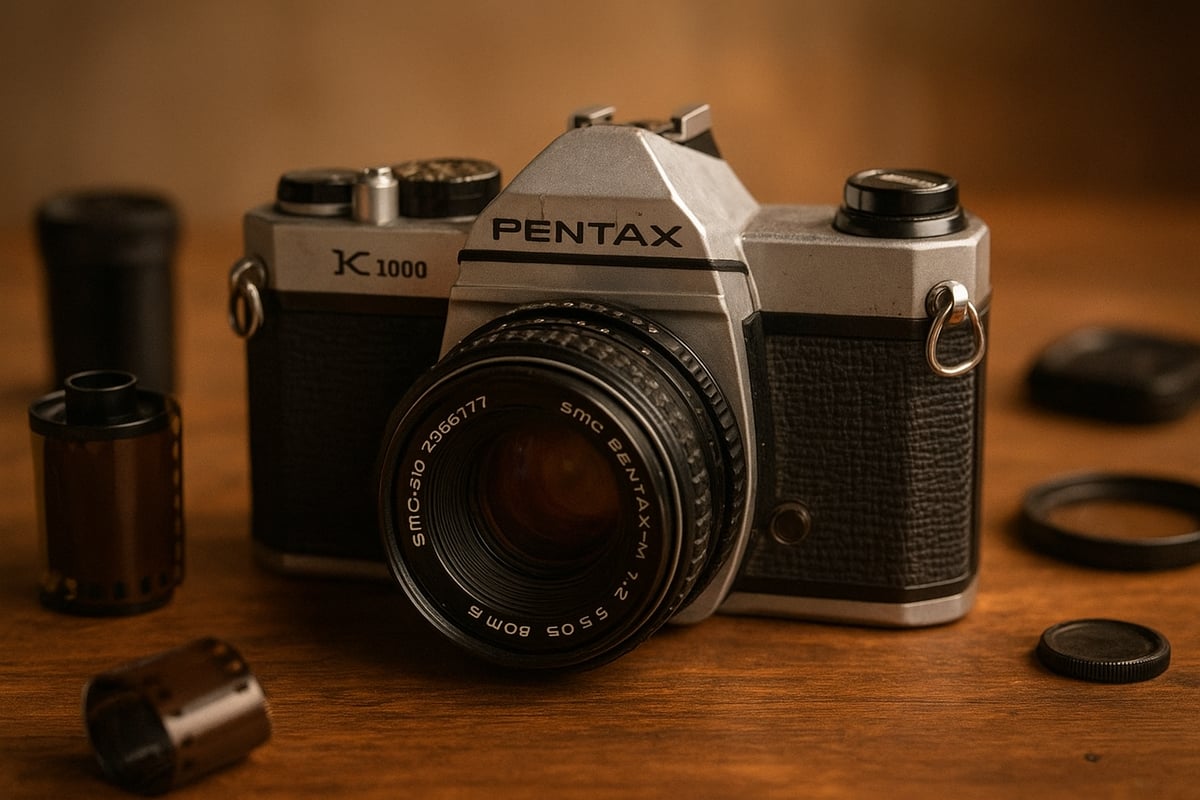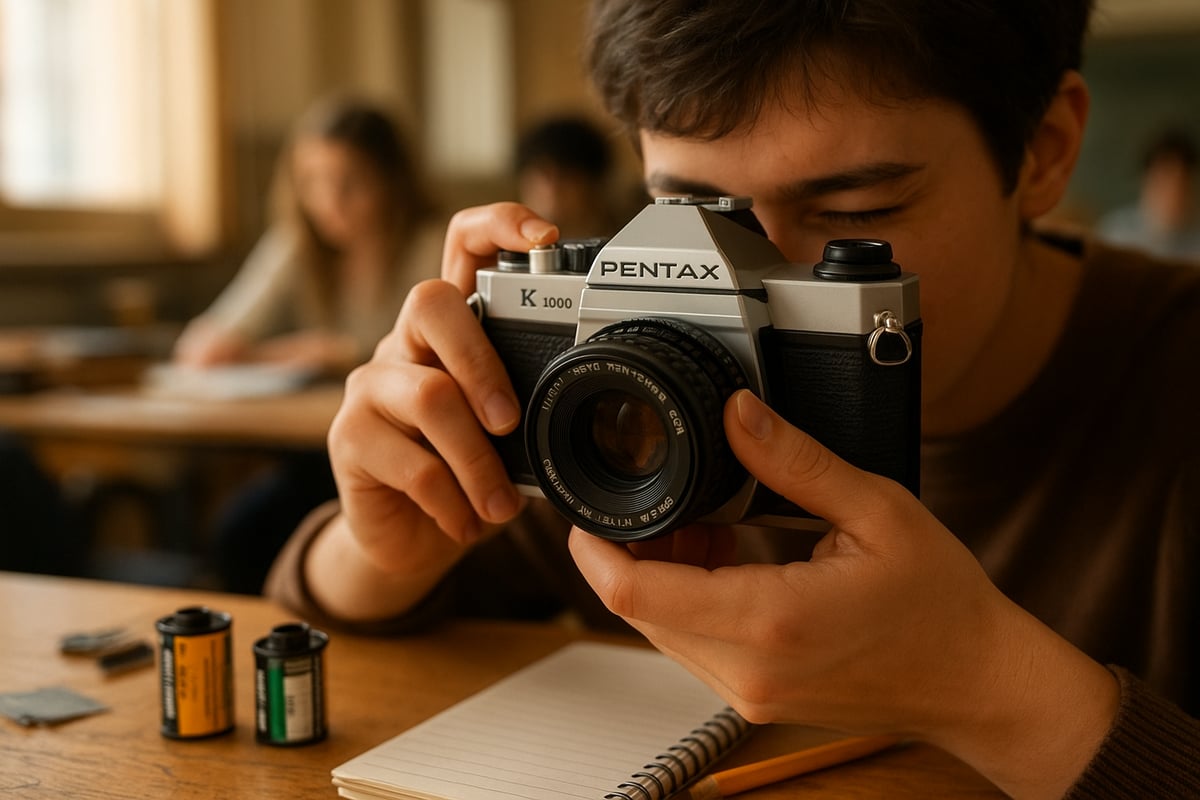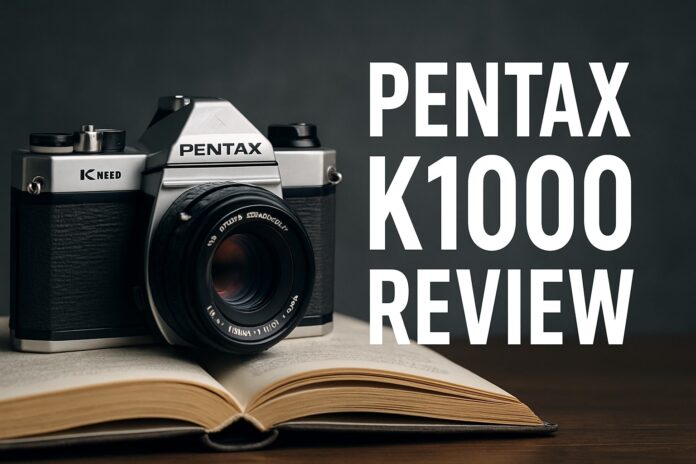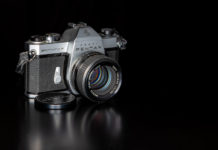Few cameras spark nostalgia and excitement like the Pentax K1000. For decades, this classic SLR has been the trusted companion of countless photographers starting their creative journeys. In this pentax k1000 review, I’ll walk you through everything you need to know in 2025, from its timeless design and hands-on usability to the real-world results it delivers. Whether you’re curious about its legendary durability, eager to explore lens options, or simply want to know if it’s still the best film camera for beginners, this guide will help you rediscover why the K1000 continues to inspire new generations. Let’s dive in and see what makes this camera a true icon.
Contents
- The Pentax K1000 Legacy: Why It Still Matters in 2025
- Design, Build, and Handling: A Closer Look
- Image Quality and Performance: What to Expect
- The K1000 for Beginners and Enthusiasts: Learning and Creativity
- Buying a Pentax K1000 in 2025: What You Need to Know
- Maximizing Your K1000 Experience: Tips, Maintenance, and Creative Projects
The Pentax K1000 Legacy: Why It Still Matters in 2025
The Pentax K1000 stands as a true icon in film photography, its legacy echoing across generations. For anyone seeking a genuine pentax k1000 review, understanding why this camera continues to matter in 2025 is essential. Its enduring presence is more than nostalgia; it is a testament to design, reliability, and the pure joy of analog shooting.

Enduring Popularity Among Film Enthusiasts
The pentax k1000 review consistently highlights the camera’s unwavering popularity among seasoned film photographers and newcomers alike. Many film enthusiasts remember the K1000 as their first serious camera, and it is still a trusted companion today. Its reputation for reliability and straightforward operation makes it a staple in classrooms and workshops across the globe.
Secondhand markets tell the story of its demand. Listings for well-maintained K1000s rarely last long, and prices have held steady, reflecting continued desire. I have met photographers who started with a K1000 decades ago and still reach for it, even as digital options multiply.
The K1000’s simplicity, paired with its cult following, ensures it remains a favorite for anyone looking to start their analog journey or revisit classic photography roots.
Timeless Mechanical Design and Durability
When conducting a pentax k1000 review, the camera’s mechanical build always stands out. The K1000’s all-metal body and purely mechanical shutter make it nearly indestructible. Many users have shared stories of their K1000 surviving drops, rain, and years of neglect, only to work flawlessly after a simple cleaning.
Compared to other vintage SLRs, the K1000’s construction feels substantial in hand. Unlike modern entry-level cameras that rely heavily on electronics, this camera’s minimal electronics contribute to its remarkable longevity. Repairs are straightforward, and spare parts are widely available. I have personally encountered K1000s that are still producing sharp, vibrant images after forty years of regular use.
This lasting durability is a key reason the K1000 continues to earn respect among film photographers, proving itself as a camera built to last.
Influence on Modern Camera Culture
The pentax k1000 review must acknowledge the camera’s influence on today’s photography landscape. The K1000’s minimalist approach, focusing on manual controls and mechanical simplicity, has inspired a new generation of camera designers. Many modern cameras, both film and digital, borrow from its clean lines and intuitive layout.
Photography courses and workshops often use the K1000 as a teaching tool, guiding students through the fundamentals of exposure and manual control. The recent revival of film photography, especially among Gen Z and Millennials, owes much to the K1000’s accessible and honest shooting experience. It has become a touchstone for those seeking authenticity in their creative process.
The K1000 in Pop Culture
No pentax k1000 review would be complete without mentioning its presence in pop culture. The K1000 appears in films, television, and photography exhibits as a symbol of genuine artistic intent. Its instantly recognizable silhouette often represents the idea of photography itself.
Several renowned photographers have spoken about their early experiences with the K1000, crediting it for shaping their understanding of the craft. Its role in art projects and visual storytelling continues today, reinforcing the camera’s status as more than just a tool—it is a cultural icon.
Design, Build, and Handling: A Closer Look
If you ask any seasoned photographer for a truly hands-on camera experience, the pentax k1000 review always comes up. This section explores why the K1000’s design and feel are still unmatched. Let’s break down the elements that make this camera such a pleasure to use in 2025.

Classic Aesthetics and Ergonomics
The pentax k1000 review would not be complete without discussing its unmistakable look. The camera’s clean lines and robust silhouette stand out even today. When you hold a K1000, you feel the solid weight of its all-metal body, balanced perfectly for steady shooting.
Compared to many vintage and modern cameras, the K1000 finds a sweet spot in size. It is compact enough to carry all day, yet substantial enough to inspire confidence. The classic black and silver finish, combined with the textured grip, makes it both visually appealing and practical.
Manual dials and levers are a joy to use. Every adjustment, from winding the film to setting the shutter speed, feels tactile and deliberate. Photographers often mention how these physical controls connect them to the process, making each shot more intentional.
Mechanical Simplicity: Fewer Features, More Focus
One hallmark of the pentax k1000 review is how the camera strips photography to its essentials. The controls are refreshingly straightforward: a shutter speed dial, ISO setting ring, film advance lever, and a simple rewind knob. No autofocus, no program modes, and certainly no digital menus.
This simplicity is empowering. With fewer distractions, users focus on learning the fundamentals of exposure and composition. When you shoot with the K1000, you quickly develop a deeper understanding of how light, aperture, and shutter speed interact.
For beginners, this hands-on approach is invaluable. It encourages experimentation and problem solving. Even experienced photographers return to the K1000 to reconnect with the basics and refine their skills.
Viewfinder and Focusing Experience
A bright, clear viewfinder is central to the pentax k1000 review. The K1000’s optical viewfinder offers generous magnification and excellent coverage, making manual focusing a pleasure rather than a chore.
Composing shots feels intuitive. The focusing screen is uncluttered, providing just the frame lines and a split-image focusing aid. Compared to other SLRs of its era, the K1000’s viewfinder stands out for its brightness and simplicity.
Users consistently praise how easy it is to nail focus, even in challenging light. Whether you are shooting portraits or street scenes, the viewfinder gives you confidence to capture the decisive moment with precision.
Build Quality and Reliability
Ask any photographer who has used the K1000 for decades, and you will hear the same refrain in their pentax k1000 review: this camera is built to last. The all-metal construction and mechanical shutter are nearly indestructible.
Unlike electronic cameras prone to failure, the K1000’s design is straightforward and easy to repair. Spare parts are widely available, and many cameras from the 1970s are still fully operational today. For a deeper dive into its rugged construction, you can consult this Pentax K1000 Overview, which highlights its durability in detail.
Photographers have taken K1000s on cross-country road trips, into dusty deserts, and through rainy city streets. Time and again, these cameras keep working, proving their legendary reliability.
Portability and Everyday Use
When it comes to daily carry, the pentax k1000 review finds the K1000 surprisingly portable. Its balanced weight makes it comfortable for long photowalks without causing fatigue.
Street photographers and travelers appreciate how the camera slips into a small bag, ready for action. The straightforward controls mean you can react quickly to fleeting moments, never missing a shot due to complicated settings.
The pentax k1000 review also notes how the camera’s minimalism fosters a mindful approach to photography. With only the essentials at hand, you are encouraged to slow down and fully engage with your subject. Whether you are capturing city life or tranquil landscapes, the K1000 remains a reliable companion for creative exploration.
Image Quality and Performance: What to Expect
The heart of any pentax k1000 review is understanding what this camera delivers in terms of image quality and performance. Whether you are picking up the K1000 for the first time or returning to film after years with digital, the results often surprise even seasoned photographers. Let us dive into what you can expect from the K1000 in the field.

Lens Compatibility and Optical Performance
One standout feature in any pentax k1000 review is the camera’s legendary K-mount. This mount opens up a vast world of lenses, both from Pentax and respected third-party makers. You can easily find everything from fast 50mm primes to wide-angle and telephoto options, giving you the flexibility to tackle any subject.
Photographers praise the classic SMC Pentax lenses for their sharpness, beautiful color rendition, and smooth bokeh. Even older glass holds up well, and the manual focusing rings are a joy to use. The K1000’s full-frame 35mm format means you capture plenty of detail, and the results feel rich and organic.
| Lens Type | Typical Use | Characteristics |
|---|---|---|
| 50mm f/2 | Everyday, Portrait | Sharp, natural look |
| 28mm f/3.5 | Landscape, Street | Wide, good edge clarity |
| 135mm f/2.8 | Portrait, Sports | Shallow depth, creamy bokeh |
No matter which lens you choose, the pentax k1000 review community agrees: you get consistent, high quality results.
Exposure Control and Metering
The K1000 features a match-needle light meter. This simple tool is a hallmark in any pentax k1000 review, as it encourages you to learn the fundamentals of exposure. The meter is powered by a single LR44 or SR44 battery, and its analog style is both intuitive and reliable.
Metering is center-weighted and generally accurate for most situations. While it is not as advanced as modern evaluative systems, it gives you direct feedback and helps you build a strong foundation in exposure. Many photographers find that using the match-needle meter teaches them to anticipate lighting challenges.
Here are a few tips for consistent exposures:
- Use the meter to set your shutter speed and aperture.
- Be mindful of strong backlight or high-contrast scenes.
- Double-check exposures when shooting slide film or tricky lighting.
For anyone starting out, the pentax k1000 review consensus is that the meter is a perfect learning companion.
Film Loading, Advancing, and Rewinding
One of the joys of the K1000 is its straightforward film handling. Loading film is a tactile process that connects you with the camera. Here is a quick guide:
1. Open the back by pulling up the rewind knob.
2. Insert the film cartridge and pull the leader across to the take-up spool.
3. Advance the film and make sure the sprockets catch.
4. Close the back and advance until the frame counter hits 1.
The film advance lever is smooth and reliable, and rewinding is just as simple. In my own pentax k1000 review, I have found the transport mechanism rarely jams, even after decades of use. If you encounter issues, check for worn sprockets or sticky advance levers, both of which are easily serviced.
This hands-on experience is part of the charm, and many photographers say it makes each shot feel more intentional.
Shutter and Flash Performance
The K1000’s mechanical shutter offers speeds from 1/1000 to 1 second, plus Bulb mode for long exposures. This range covers most creative needs. The shutter is fully mechanical, so it works even if the battery dies, a key point in any pentax k1000 review.
Flash sync is set at 1/60 second, which is typical for cameras of this era. You can use any hot-shoe or PC-sync compatible flash. While the K1000 does not offer TTL flash metering, using a manual flash is straightforward once you get used to setting the aperture for flash output.
For long exposures or creative effects, the Bulb setting and threaded cable release make night photography or light painting accessible. Shutter reliability is excellent, and most K1000s keep accurate speeds for decades with minimal maintenance.
Real-World Shooting Scenarios
The pentax k1000 review is not complete without discussing real-world results. This camera has been a trusted companion for portraits, landscapes, and street photography worldwide. With the right lens and film, you can achieve everything from crisp, detailed landscapes to intimate, character-rich street scenes.
Try pairing a 50mm f/1.7 with Kodak Portra for soft, lifelike portraits, or load Ilford HP5 for classic black-and-white street shots. The K1000’s mechanical feel encourages you to slow down and compose with intention.
For further reading and a personal take on the camera’s performance in various genres, check out this Pentax K1000 Review. Many photographers echo the sentiment that the K1000 is more than a tool, it is a creative partner that brings out the best in your work.
Whether you are shooting your first roll or returning to film after years away, the pentax k1000 review experience is both inspiring and rewarding.
The K1000 for Beginners and Enthusiasts: Learning and Creativity
The pentax k1000 review often highlights why this camera remains a favorite among both newcomers and seasoned photographers. If you are stepping into film photography or rekindling your creative spark, the K1000 stands as a reliable companion. Its simplicity and robust design make it a true hands-on learning tool, while its cult following ensures you are never alone on your journey.

Why the K1000 Is the Ultimate Learning Tool
The pentax k1000 review always circles back to its full manual operation. With every setting in your hands, you learn the heart of photography—exposure, focus, and composition. Many educators choose the K1000 for workshops, as it strips away distractions and lets students see the direct results of their choices.
Teachers frequently share stories of students who, after mastering the basics with a K1000, develop a deeper appreciation for the craft. The camera encourages you to slow down, think about light, and truly engage with each shot. If you are weighing your options, the Best Camera for Beginners guide compares the K1000 to other entry-level models and confirms its place as a top choice for learning.
Fostering Creativity Through Limitations
One of the greatest lessons from any pentax k1000 review is how limitations can spark creativity. Without automatic modes, you are invited to experiment. Try shooting a roll on a single ISO, or work within the constraints of a fixed lens. These self-imposed projects help you see the world differently.
Some photographers use the K1000 for creative assignments, like double exposures or challenging lighting conditions. Others find their personal style by embracing the quirks of film. Limiting your tools can paradoxically expand your creative boundaries, letting you focus on vision rather than gear.
Accessibility and Affordability in 2025
In 2025, the pentax k1000 review remains positive about its affordability. Used bodies and lenses are still widely available, making it accessible for most budgets. Compared to new digital cameras or other vintage SLRs, the K1000 often offers better value for money.
Accessories such as straps, light meters, and film are easy to find. Even specialty films are affordable, allowing you to experiment without breaking the bank. The K1000’s robust build also means you are less likely to face costly repairs, which is a huge plus for beginners.
Community and Support Resources
A pentax k1000 review would not be complete without mentioning its vibrant community. Online forums, dedicated social media groups, and local meetups are filled with users eager to help. You will find repair guides, photo challenges, and encouragement from photographers around the globe.
If you need support, there are repair services specializing in the K1000, and online user groups where you can troubleshoot any issue. Participating in these communities can make your journey with the K1000 richer, offering inspiration and practical advice at every step.
Buying a Pentax K1000 in 2025: What You Need to Know
The search for an authentic Pentax K1000 is a rite of passage for many analog lovers. As demand continues to surge, knowing where to buy and how to inspect a camera is as vital as the pentax k1000 review itself. Let’s break down the essentials for a confident purchase in 2025.
Where to Find Authentic K1000s
Finding a genuine Pentax K1000 in 2025 is easier if you know where to look. Trusted online marketplaces such as eBay, KEH, and B&H Photo often have listings, but inventory moves quickly. Local camera shops, estate sales, and photography swap meets can also yield hidden gems.
Always verify seller ratings and request detailed photos. Meeting sellers in person, when possible, lets you inspect the camera firsthand.
Evaluating Condition: What to Check Before Buying
A thorough inspection is crucial for any pentax k1000 review process. Start by checking the shutter speeds for accuracy and smooth operation. Look through the viewfinder for clarity and ensure the light meter needle responds to changes in light. Test the film advance lever and rewind knob for resistance or stiffness.
Inspect the battery compartment for corrosion, and check for light leaks by shining a flashlight inside the film chamber with the back closed. Surface wear is common, but deep scratches or dents may indicate rough handling.
Understanding Model Variations and Serial Numbers
The pentax k1000 review process often uncovers subtle differences among models. Early versions feature Asahi branding and were made in Japan, while later ones may be marked Pentax and produced in China or Hong Kong. Serial numbers can help date your camera and determine collectible value.
Functionally, all versions offer the same core experience, but some collectors prefer the heft and finish of the earliest models. Knowing these distinctions can help you make an informed choice and spot a fair deal.
Price Trends and Value for Money
With film photography’s resurgence, prices for the K1000 have climbed but remain reasonable compared to other vintage SLRs. Most bodies in good shape range from $150 to $300, with lens kits adding to the total. Rarity, cosmetic condition, and included accessories all affect value.
If you are comparing options, check out the Best Pentax Cameras Guide for a broader context on where the K1000 sits in the current lineup. This can help frame your pentax k1000 review against alternatives.
Essential Accessories and Upgrades
A complete pentax k1000 review would not be finished without discussing essential extras. Quality camera straps, a manual light meter, lens cleaning tools, and a protective case are smart investments. For creative flexibility, consider adding a 50mm f/2 lens, a wide-angle, or even a vintage Pentax flash.
Spare batteries for the light meter and fresh film rolls should always be on hand. Accessories are widely available, and many modern options fit the K1000 seamlessly.
Tips for First-Time Buyers
If this is your first pentax k1000 review as a buyer, approach the process with patience. Ask sellers about the camera’s service history and request sample images if possible. Before finalizing, test all functions and negotiate respectfully.
Bring a checklist when meeting in person, and do not hesitate to walk away if something feels off. Learning from others’ experiences, as detailed in many community forums and guides, can help you avoid common pitfalls.
Maximizing Your K1000 Experience: Tips, Maintenance, and Creative Projects
Owning a Pentax K1000 is more than just having a camera; it’s about immersing yourself in the craft of photography. Whether you’re a newcomer or a seasoned shooter, this section of the pentax k1000 review will guide you through essential care, troubleshooting, film choices, creative techniques, personal projects, and building connections in the film community.
Essential Maintenance and Care
Routine maintenance ensures your Pentax K1000 delivers reliable results for years. I recommend a gentle cleaning after every outing. Start by using a blower to remove dust from the lens and body. Wipe the exterior with a microfiber cloth. Use a soft brush for the viewfinder and dials.
Change light seals and foam every few years, especially if you notice sticky residue or light leaks on your film. Kits are available online, and the process is straightforward: remove the old foam, clean the area with isopropyl alcohol, and carefully install the new pieces.
Replace the battery for the light meter annually, even if it still works. Always store your camera in a cool, dry place. For longer storage, remove the battery and keep the camera in a protective case to prevent corrosion or dust buildup. Consistent care remains a cornerstone of any pentax k1000 review.
Troubleshooting and DIY Repairs
Even with solid build quality, issues can arise. If you encounter a stuck shutter, gently advance and release the shutter several times. Sluggish film advance often means old lubrication; a professional cleaning may be needed.
For a non-responsive meter, check the battery and contacts. Clean corroded terminals with a cotton swab and a bit of vinegar. Light leaks usually stem from degraded seals; replacing them often solves the problem.
Common issues and solutions:
- Shutter not firing: Confirm battery placement and check for obstructions.
- Film advance jammed: Remove the film and gently reset the mechanism.
- Meter needle erratic: Replace the battery or clean contacts.
When repairs go beyond your comfort zone, reputable shops and online tutorials are available. Many enthusiasts document their fixes, making the pentax k1000 review process a shared journey.
Choosing the Best Film Stocks for the K1000
Film choice shapes the character of your images. The Pentax K1000 handles a broad range of stocks, letting you experiment with color, black-and-white, and specialty emulsions.
Popular options:
| Film Stock | ISO | Color/Mono | Characteristics |
|---|---|---|---|
| Kodak Portra 400 | 400 | Color | Fine grain, accurate skin tones |
| Ilford HP5 Plus | 400 | B&W | Classic look, flexible latitude |
| Fujifilm Superia X-TRA | 400 | Color | Vibrant colors, general use |
| Kodak Tri-X 400 | 400 | B&W | Bold contrast, timeless style |
Each stock brings something unique to your pentax k1000 review experience. Try different ISOs for various lighting, and note how grain and color palette affect your results. Many users develop favorite films that suit their shooting style.
Creative Shooting Techniques
The Pentax K1000’s manual controls invite experimentation. Double exposures are easy—after taking a shot, hold the film rewind button and re-cock the shutter, exposing the same frame twice. For long exposures, use a tripod and the bulb setting to capture night scenes or light trails.
Filters open new possibilities. A polarizer deepens skies, while colored filters enhance contrast in black-and-white photography. Lens attachments like close-up filters or vintage glass can change your perspective.
If you’re exploring which styles best fit your interests, the Types of Photography You Must Learn guide offers inspiration for genres from street to landscape. Each technique enriches your pentax k1000 review by transforming routine shots into personal art.
Building a Personal Project with the K1000
A long-term project can deepen your skills and give coherence to your work. Start by choosing a subject or theme—urban life, seasonal changes, or family moments. Set a goal, like one roll per week or a photo series over several months.
Document your progress. Keep a journal with notes on settings, film stock, and creative decisions. Share your results online or in zines to connect with others. Many K1000 users find that personal projects turn a pentax k1000 review into a meaningful journey, not just a technical assessment.
Connecting with the Film Photography Community
The film community thrives online and offline. Join forums, social media groups, or local meetups dedicated to the Pentax K1000. Participate in photo walks, workshops, and challenges to exchange ideas and get feedback.
Opportunities abound for exhibitions and collaborative projects. Many photographers find motivation and inspiration from these connections, elevating their pentax k1000 review with shared experiences and learning.
Whether you’re maintaining your gear, troubleshooting issues, experimenting with film, or building a creative project, the Pentax K1000 rewards dedication. Embrace the process, and you’ll find that every frame tells a story worth sharing.



